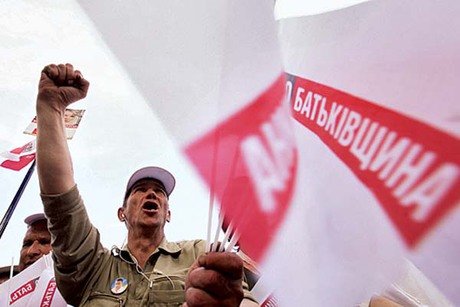This week was dominated by the fallout of the May 18 rallies in Kyiv and beating of two journalists by hired enforcers. Followed media protests, cover-ups, a parliamentary hearing and the stripping of cabinet accreditations of journalists by an angry Prime Minister Mykola Azarov because they dared to demand action.
These events once again underscored Ukraine many failures, in regards to freedoms of expression, political activity and assembly, as well as the dangerous links between politics and the criminal world. The Kyiv Post brings you the highlights of these events.
Kyiv Post staff writer Svitlana Tuchynska can be reached at [email protected]
May 18, 12 a.m. An estimated 15,000 people gather for an oppositional Rise, Ukraine! rally in Kyiv. Many in the crowd are disappointed because the opposition leaders fail to present a joint action plan and single candidates for the Kyiv mayor and presidential elections. To accommodate the crowd opposition leaders vow to come up with a single candidate by 2015.

1 p.m. The ruling Party of Regions kicks off its own rally. Named “To Europe without fascists,” the rally is mostly about bashing right-wing opposition members. Thousands of participants are bused into Kyiv from across the nation to take part in the rally.

2 p.m. An armored personnel carrier attempts to enter Sofiyska Square, where the opposition rally is taking place, despite strict traffic limitations. Numerous photos show the vehicle being escorted by traffic police cars. A person dressed up as a rabbit dances on the vehicle, dangling carrots, in a reference to Batkivschyna leader Arseniy Yatseniuk, who is mockingly called a rabbit by critics. Dozens of Svoboda party members attack the vehicle on Volodymyrska Street, smashing its windows. A policeman is filmed driving it.

2.20p.m. Journalist Olha Snitsarchuk of Channel 5 arrives on the scene to report on the clash and is attacked by a group of men. Snitsarchuk’s husband, Vlad Sodel, a photographer for Kommersant Ukraine newspaper, rushes to her defense. He takes pictures during the attack that go viral later. They show police, present at the scene, ignoring the fight. The attackers are later identified as guards from the Party of Regions rally. Snitsarchuk reports her beating to the police. Her report becomes the basis for a criminal case.

4 p.m. Spilna Sprava (Common Cause), a non-profit civil society organization installs tents on Sofiyska Square and vows to keep protesting. The tents are soon destroyed by Berkut riot police and activists are beaten and detained.

5.30 p.m. A spontaneous protest breaks out by the interior ministry building. Activists and journalists demand a swift and complete investigation into the attacks on journalists earlier and punishment of the guilty. They also pressure the interior ministry into reclassifying the criminal case by adding another article to it – obstruction of a journalist’s professional activity – which in grave cases can result in up to three years in jail.

May 20 By now, most suspects who took part in the May 18 attacks are identified by the joint work of Ukraine’s online community. As journalists and activist gather for another rally in front of the Interior Ministry demanding the minister’s resignation for inaction, one of the top suspects Vadim Titushko, releases a video on YouTube, saying he was trying to protect the journalist, not beat her. Titushko claimed he was hired by the opposition as a guard for Hr 250.

May 21 Interior Minister Vitaliy Zakharchenko shows up in parliament for an ad hoc hearing on the case, as his ministry reports it detained the chief suspect. In the midst of laughs and hooting, Zakharchenko claims the armored personnel vehicle was “a part of the opposition’s entourage.” He claims a policeman was driving the vehicle after confiscating it. Despite video evidence, he denied the vehicle was escorted by traffic police.

May 22. Kyiv’s Shevchenkivsky District Court releases chief suspect Titushko on bail of Hr 22,940. Titushko is banned from traveling outside his home town of Bila Tserkva in Kyiv Oblast. The court hearing was held behind closed doors and the media were only admitted to the courtroom only to hear the ruling.

May 22 In the meantime, 10 journalists stage a silent protest in the middle of a Cabinet of Ministers meeting, demanding a full investigation of the recent incident with their colleagues. They turn their backs to Cabinet members, and hang notes from their backs warning that it’s their wives who could be beaten next. The protest angers Prime Minister Mykola Azarov, who orders to strip the journalists of their accreditation that allows them to cover the government issues.
May 23 Following more protests and a media campaign, Azarov backpeddles on his decision to pull the credentials of journalists the next day.

